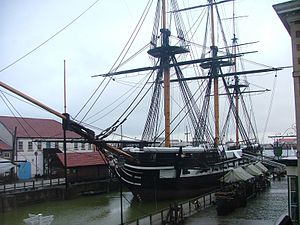Leda-class frigate

HMS Trincomalee, one of the two surviving members of the class.
|
|
| Class overview | |
|---|---|
| Name: | Leda class |
| Operators: |
|
| Subclasses: | Modified Leda class |
| Built: | 1805 - the last 2 ordered were cancelled in 1832 |
| Planned: | 53 |
| Completed: | 47 |
| Cancelled: | 6 |
| Preserved: | 2 |
| General characteristics | |
| Class and type: | 38-gun frigate |
| Tons burthen: | 1062 79⁄94 (bm) |
| Length: |
|
| Beam: | 39 ft 11 in (12.17 m) |
| Depth of hold: | 12 ft 9 in (3.89 m) |
| Sail plan: | Full-rigged ship |
| Complement: | 284 (later 300); |
| Armament: |
|
The Leda-class frigates, were a successful class of forty-seven British Royal Navy 38-gun sailing frigates constructed from 1805-1832. Based on a French design, the class came in five major groups, all with minor differences in their design. During their careers, they fought in the Napoleonic Wars and the War of 1812. Forty-five of the 47 were eventually scrapped; two still exist.
The design of the name ship, Leda of 1800, was based on Sané's design for the French Hébé-class frigate. The British 44-gun fifth rate HMS Rainbow captured Hébé in 1782. (The British took Hébé into service as HMS Hebe but in 1805 renamed her HMS Blonde). The class of frigates built to the lines of Leda were in contemporary parlance called the 'Repeat Leda class'.
Pomone, the first ship of the class, was built using Josiah Brindley's patent method of construction which dispensed with wooden 'lodging' and 'hanging knees', oak elements which had to be grown to shape, using instead iron fastenings and iron knees. Oak suitable for shipbuilding had become increasingly difficult to obtain through the long period of warfare.
The vessels of the class were fast, most recording 13 knots (24 km/h; 15 mph) large and 10 knots (19 km/h; 12 mph) close-hauled. However, their French-style proportions made them unweatherly compared to frigates designed to British proportions (such as the Lively class). Many captains requested additions to the frigates' false keels to remedy this. The Leda class stood to their canvas well and liked a stiff gale, but were prone to excessive pitching in very heavy seas. All captains complained of the class's poor stowage capacity, the result of their fine French underwater lines, but stowage improved after the introduction of iron fresh-water tanks. Lastly, captains considered the class to be "wet", a result of lively rolling and pitching causing seams to loosen.
...
Wikipedia
